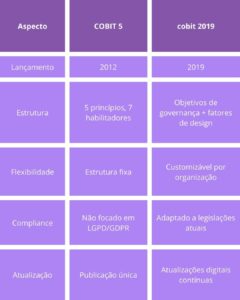What is COBIT and why is it essential for IT Governance?
Information Technology has gone from being merely an operational support to a strategic pillar within companies. In this scenario, COBIT (Control Objectives for Information and Related Technologies) emerges as a globally recognized IT governance and management framework, developed by ISACA.
Its main objective is to align IT with the business's strategic objectives, ensuring that technology investments deliver effective results, security, and compliance.
Brief history of COBIT
COBIT was launched in 1996 by ISACA, initially focused on IT auditing and control. Over the years, it has evolved to become a benchmark model for IT governance, covering everything from strategic planning to risk monitoring.
-
COBIT 1 and 2: focused on auditing and basic controls.
-
COBIT 3 and 4: greater focus on corporate governance and strategic alignment.
-
COBIT 5 (2012): unified frameworks such as Val IT and Risk IT, expanding their reach.
-
COBIT 2019: he brought flexibility, adaptation to the digital scenario and regulatory compliance (LGPD and GDPR).
How does COBIT work?
COBIT covers 34 processes and 210 control points, organized into four domains:
- Planning and Organization: Defines IT strategy and aligns it with business objectives.
- Acquisition and Implementation: Manages the acquisition and implementation of IT solutions.
- Delivery and Support: Ensures efficient delivery and ongoing support of IT services.
- Monitoring and Evaluation: Monitors IT performance and ensures compliance with policies and regulations.
How COBIT supports corporate and IT governance
COBIT acts as a bridge between business and technology, helping managers to:
-
Define clear responsibilities in IT governance.
-
Minimize cyber risks and operational failures.
-
Increase efficiency of technological processes.
-
Meet regulatory requirements and compliance.
COBIT 5: main features and limitations
The fifth version of Cobit is considered one of the leading IT governance methodologies on the market. Launched in 2012, it presents five fundamental principles that allow for intelligent use of technological infrastructure and help a company achieve goals. These are: Meet stakeholder needs; Cover the organization end-to-end; Apply a single, integrated framework; Enable a holistic approach; Separate governance from management.
With an adequate use of the concepts established in Cobit 5, it is possible to obtain several benefits, such as:
- Maintenance of the data storage structure with security and integrity;
- More focus on strategic objectives with IT support;
- Improved performance and reliability of the Information Technology infrastructure;
- Reduction of risks related to the integration of IT with other segments of the company;
- Optimization of expenses related to the use of technological solutions;
- Easier to adopt compliance rules efficiently.
How it was applied in companies
Many organizations have used COBIT 5 to:
– Structure IT processes.
– Define performance metrics (KPIs).
– Implement information security practices.
– Improve communication between IT and business areas.
Points of attention and challenges
Despite being robust, COBIT 5 presented some practical challenges:
– Less flexibility in the face of rapid technological changes.
– Structure considered complex by some companies.
– Need for local adaptations, as it did not always meet specific regulatory contexts.
COBIT 2019: evolution and news
Updated structure and principles
COBIT 2019 maintained the essence of COBIT 5, but introduced a more dynamic and adaptable model. Among the new features:
-
Governance components (design factors and governance objectives).
-
Continuous updating through digital publications.
-
Better alignment with international standards (ISO/IEC 38500).
What has changed in relation to IT governance
While COBIT 5 had a more structured focus, COBIT 2019 now allows for customizations based on the organization's profile. Furthermore, it places greater emphasis on cyber risks and regulatory compliance (such as LGPD and GDPR).
Flexibility and adaptation to the digital scenario
The 2019 version better adapts to the demands of digital transformation, offering guidelines that adapt to companies of different sizes and sectors.
Benefits for modern companies
Among the main gains of COBIT 2019 are:
-
More agile and responsive management to technological changes.
-
Reducing information security risks.
-
Greater operational efficiency.
-
Support for innovation and competitiveness.
Differences between COBIT 2019 and COBIT 5
Practical impacts for IT and Governance managers
With COBIT 2019, managers have greater clarity to:
-
Prioritize investments in technology.
-
Adapt IT to legal requirements.
-
Ensure that technology is an engine of growth.
Governance domains and objectives in COBIT 2019
COBIT 2019 organizes governance into domains, each with specific objectives:
- APO (Align, Plan and Organize)
- EDM (Evaluate, Guide and Monitor)
- DSS (Deliver, Serve and Support)
- BAI (Build, Acquire and Implement)
These domains ensure that IT is aligned with the business and constantly improving.
How to implement COBIT 2019 in your organization
Initial step by step
-
Assess the current level of IT maturity.
-
Define strategic business objectives.
-
Select relevant design factors.
-
Map critical IT processes.
Best practices and recommendations
– Involve senior management from the beginning.
– Carry out continuous training.
– Use clear performance metrics.
– Adapt the framework to the company’s reality.
Common mistakes to avoid
– Implement without leadership support.
– Treat COBIT as bureaucracy and not as strategy.
– Ignoring the need for periodic reviews.
COBIT 2019 as a reference for modern IT Governance
COBIT 5 was essential for consolidating IT governance, but COBIT 2019 brought a more flexible, modern model aligned with digital transformation.
Companies still using COBIT 5 should consider upgrading to COBIT 2019, ensuring not only regulatory compliance but also greater competitiveness.
THE 4MATT is an IT Governance specialist and can help your company implement COBIT 2019. Contact us and discover how we can transform your challenges into results.




